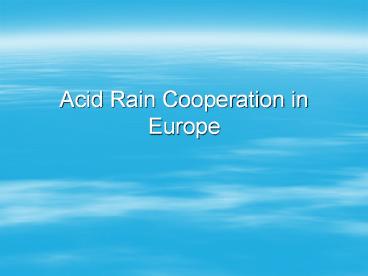Acid Rain Cooperation in Europe - PowerPoint PPT Presentation
Title:
Acid Rain Cooperation in Europe
Description:
Acid Rain Cooperation in Europe. The Problem. Svante Oden (1968): 'The ... Acid Rain Cooperation in Europe. Success or least common denominator agreements? ... – PowerPoint PPT presentation
Number of Views:131
Avg rating:3.0/5.0
Title: Acid Rain Cooperation in Europe
1
Acid Rain Cooperation in Europe
2
The Problem
- Svante Oden (1968) The Acidification of Air and
Precipitation and its Consequences. - SOx, NOx -gt transported over the continent
-gtform acids in precipitation or dry form - Damage to health, forests, lakes, soils,
ecosystems particularly in Sweden, Norway - International environmental externality
3
The Actors
- Leaders Sweden, Norway
- 1972 Conference on the Human Environment
- Laggards UK, Germany, Communist Eastern Europe
4
The Breakthrough
- 1975 Helsinki Conference on Security and
Cooperation in Europe - USSR and US interested in détente
- Environment the most convenient object of
cooperation - Scandinavians saw an opportunity, so did Canada
- The UN Economic Commission for Europe lead
agency - Long-Range Transboundary Air Pollution Convention
(LRTAP), 1979 - EMEP Protocol (1984)
5
More Lead Actors
- West Germany the death of the Black Forest
- 30 club Scandinavians, W. Germany, Austria,
Switzerland, Canada, France - The First Sulfur Protocol (1985)
- 30 of 1980 emissions by 1993
6
The Protocols
- The Nitrogen Oxides Protocol (1988)
- Freeze emissions at 1987 levels by 1995
- VOC Protocol (1991)
- 30 of emissions (base b/w 1984 and 1990) by
1999. - The Second Sulfur Protocol (1994)
- Differentiated targets bases on critical loads
for acidification for 2000 and 2010technology
standards - The Protocol on Heavy Metals (1998 )
- The Protocol on POPs (1998)
- Gothenburg Multipollutant Protocol (1999)
7
Regulatory Innovation
- Critical loads the highest load that will not
cause chemical changes leading to long-term
harmful effects on the most sensitive ecological
ecosystems (Levy 1995, p. 61). - Why negotiate on the basis of critical loads
estimates?
8
Critical Loads for Acid Deposition(red-high
sensitivity, blue low)
9
The RAINS Model
- Integrate science in international policy
- Emissions module
- Cost module
- Dispersion module
- Effects module (critical loads)
10
Second Sulfur Protocol Correlation of SO2
Emission Ceilings and RAINS Recommendations
11
Second Sulfur Protocol (1994)
- 60 gap closure against critical loads
- Differentiated targets
- Requirement to apply BAT, achieve up to 90
desulfurization of emissions from large sources
12
(No Transcript)
13
The Gothenburg Protocol (1999)
- Multiple effects Acidification, Eutrophication
and Ground-level Ozone - Multiple pollutants emission ceilings for SOx,
NOx, VOCs and ammonia (NH3) by 2010 - Based on RAINS outputs
- Emission limits for large combustion sources, dry
cleaning, cars, trucks based on BAT - If implemented, Europes sulfur emissions should
be cut by 63, its NOx by 41, VOC by 40, and
ammonia by 17 compared to 1990.
14
Gothenburg Protocol Correlation of SO2 emission
ceilings and RAINS Recommendations
15
EU Directives
- Large Combustion Plant Directive (1988)
- Large Combustion Plant Directive II (2001)
- National Emissions Ceilings Directive (2001)
16
Acid Rain Cooperation in Europe
- Success or least common denominator agreements?
17
Emissions in the ECNOx-24 SO2 -58
18
Air Pollution in the US
19
Acidifying Emissions in Central and Eastern
Europe
20
ConclusionsWhat facilitates cooperation?
- Information change of strategies/interests
- Issue linkage (both within regime and other
regimes e.g. EU) - Science-policy linkage
- Small number of actors easier to overcome
collective action problems
21
- RAINS Asia?































